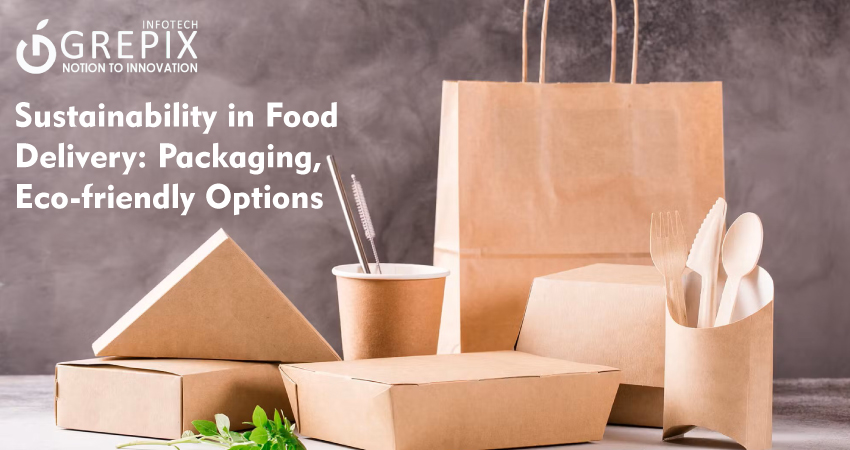Sustainability in Food Delivery: Packaging, Eco-friendly Options
Sustainability in food delivery is no longer a mere trend it’s becoming the industry standard. With food delivery market revenue crossing USD 112.67 billion globally in 2023, the environmental impact of packaging, transportation, and logistics is under intense scrutiny. Today’s consumers care deeply about how their meals are sourced, delivered, and packaged, prioritizing eco-friendly options and demanding transparency at every step.
Platforms, restaurants, and packaging companies are collaborating to minimize their carbon footprints. Innovations such as electric fleets, biodegradable containers, and green food delivery apps reflect an industry-wide shift toward sustainability in food delivery. These efforts are driven not only by environmental responsibility but also by growing consumer demand for ethical and eco-conscious choices.
Sustainable food delivery is rapidly transforming how meals reach our tables. Today's consumers seek eco-friendly packaging and green food delivery app solutions that lower environmental impact while offering convenience and quality. From biodegradable containers to carbon-neutral delivery fleets, innovative brands are helping to tackle the mounting concerns of single-use plastics, food waste, and excessive emissions. Technology such as AI-driven logistics and transparent sourcing is empowering both platforms and users to make eco-conscious choices. This in-depth guide explores the environmental challenges, successful examples, and the latest trends in sustainability in food delivery, highlighting the brands and solutions making a real difference in the ecosystems of urban and global foodtech.
Environmental Impact of Delivery: The Urgency of Sustainable Food Delivery
Food delivery involves complex supply chains and significant energy consumption. Traditional delivery methods result in:
- Huge volumes of single-use plastic waste.
- Increased carbon emissions via fuel-powered vehicles.
- Excess food waste due to inefficient logistics.
A recent study found 45% of waste in U.S. landfills is from food and packaging, and carbon emissions from food delivery increased by 32% in 2022 alone. The global food delivery market’s rapid expansion, with revenues projected to reach $302.5 billion by 2027, exacerbates these problems.
Key Environmental ChallengesM
- Packaging Waste: Disposable plastics and traditional packaging contribute to pollution and landfill overload.
- Carbon Footprint: Delivery logistics often rely on fossil fuels, adding to greenhouse gas emissions.
- Food Waste: Overproduction and inefficient inventory management lead to unnecessary disposal of edible goods.
Efforts for sustainable food delivery include carbon-neutral delivery vehicles, optimized routing, and reduced reliance on single-use plastics all geared to minimize negative impacts and advance sustainability in food delivery.
Sustainable Packaging: Eco-Friendly Solutions for Food Delivery
Eco-friendly packaging is central to sustainable food delivery. Leading brands and startups have pioneered a range of alternatives that address safety, hygiene, and environmental responsibility.
Examples of Eco-Friendly Packaging
Biodegradable Containers: Made from bagasse, bamboo, and plant-based polymers, these containers decompose faster and do not leach harmful chemicals.
- Edible Packaging: Innovations like Nestlé India’s wheat-flour edible forks cater to both taste and eco-consciousness.
- Reusable Kits: Participating platforms incentivize container returns, reducing overall waste.
- Water-Soluble Films:Startup solutions ensure safe food retention and disposal.
- Seaweed-Based Polybags: Brands like Le Club and Alex Crane use bio-materials to replace traditional plastic packaging.
- Recycled and Compostable Mailers: Companies like Scentbird and Fjällräven now ship products in recycled materials, promoting circular solutions.
Case Studies in Sustainable Packaging
| Brand | Innovation | Impact |
|---|---|---|
| Unilever | 50% less virgin plastic | Mass reduction of waste |
| Nestlé | 100% recycled PET jars | Circular economy boosting |
| Coca-Cola | PlantBottle technology | 50% recycled content goal |
| Le Club | Seaweed film packaging | First in swimwear sector |
| Scentbird | Recycled mailers for delivery | Lowered carbon footprint |
These examples prove that innovation in eco-friendly packaging provides a competitive edge for businesses while meeting consumer expectations for sustainability in food delivery.
Statistics
- Nearly 30% of global waste is attributed to plastic packaging.
- Over 80% of consumers prefer brands that use sustainable packaging.
- Many countries now regulate single-use plastics, driving adoption of green alternatives.
Green Delivery Methods: Reducing Emissions and Food Waste
Advancing green food delivery app solutions and logistics is integral to minimizing the environmental impact of last-mile delivery.
Electric & Low-Emission Fleets
- Electric scooters, bikes, and two-wheelers are replacing fossil-fuel vehicles, with major platforms in India and abroad rolling out these fleets, often enabled by government incentives.
- AI-powered logistics optimize routes, reducing fuel use and emissions.
Carbon-Neutral and Bulk Deliveries
Platforms now offer carbon-neutral delivery options that may offset emissions via reforestation or renewable energy projects. Bulk packaging solutions also reduce packaging waste per order.
FoodTech Innovations
- Real-time demand forecasting powered by AI helps minimize food waste by aligning preparation with actual orders.
- Some apps feature choice architecture, nudging consumers toward lower carbon menu items.
- Electric bikes and batch deliveries in densely populated areas reduce both fuel and packaging waste.
Real-Life Examples
- Green Spoon food delivery app: Connects users with top-tier local restaurants, emphasizes unbeatable prices, real-time updates, and eco-friendly ordering with expansion plans across India.
- Green Food app: Fast, AI-powered delivery fleet capable of 10-minute fulfillment, coupled with inventory scans, creates optimized and eco-friendly customer experiences.
These green delivery methods demonstrate the practical opportunities for businesses and consumers to contribute to sustainability in food delivery.
Eco-Friendly Branding: Tools for Building Trust and Loyalty
Eco-friendly branding can turn sustainability in food delivery into a differentiator that drives user loyalty and conversion.
Strategies for Green Branding
- Marketing Sustainability: Platforms clearly communicate green initiatives, carbon offset programs, and eco-friendly packaging to attract environmentally conscious consumers.
- Transparent Sourcing and Logistics: Brands disclose the origin of ingredients, the lifecycle of packaging, and the nature of their delivery fleets, helping consumers make informed choices.
- Partnerships with NGOs: Many apps and restaurants collaborate with environmental groups to support broader sustainability goals.
- Education Initiatives: Circular economy programs help consumers understand the importance of sorting waste and returning reusable containers.
Industry Recognition
Companies earning sustainability certifications and eco-badges see higher engagement and retention. In India, compliance with the Plastic Waste Management Rules and similar legislation is now vital for brand reputation.
Real-World Impact
- Platforms like Swiggy, Green Spoon, and Zomato promote green packaging and delivery, building a cultural shift toward responsible consumption.
- Consumer trust and brand value increase alongside sustainability commitments.
Conclusion
Sustainability in food delivery, through eco-friendly packaging and green delivery methods, is reshaping how we enjoy meals at home. With innovations ranging from biodegradable containers to electric vehicle fleets and transparent sourcing, businesses are paving the way for greener cities and healthier environments. Real-life case studies highlight the commercial and environmental successes of these approaches, supported by rising consumer demand and regulatory pressure.
The challenge remains for every stakeholder businesses, governments, and consumers to accelerate adoption and spread awareness. Choosing sustainable food delivery and eco-friendly packaging isn’t just an ethical decision; it’s an investment in healthier communities and more resilient supply chains. Make a positive difference adopt green food delivery app solutions and share these insights with others to power the transition to sustainability in food delivery.
FAQs
1. What are the best eco-friendly packaging options for food delivery?
Biodegradable containers made from plant materials, edible packaging like wheat-based cutlery, and recyclable mailers are leading options in sustainable food delivery.
2. How can a food delivery app be truly green?
A green food delivery app integrates low-emission delivery fleets, offers transparent sourcing, and incentivizes users to opt for sustainable packaging and carbon-neutral delivery.
3. Why is sustainability important in food delivery?
It addresses environmental challenges like plastic waste, carbon emissions, and food waste while meeting growing consumer demand for ethical and responsible consumption.
4. Which brands lead in sustainable food delivery practices?
Unilever, Nestlé, Coca-Cola, Green Spoon, and Green Food have pioneered eco-friendly packaging and logistics solutions, driving sustainability in food delivery.
5. What can consumers do to support sustainability in food delivery?
Choose restaurants and delivery platforms offering eco-friendly packaging and green delivery options, participate in container return and recycling programs, and stay informed about sustainability trends.







